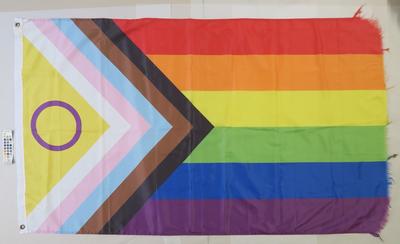Progressive intersex flag
Description
Progressive intersex flag: on the left is a purple circle superimposed over a yellow triangle, bordered by a five-coloured chevron of black, brown, blue, pink and white. Extending from the chevron are six horizontal stripes of equal width from top to bottom in red, orange, yellow, green, blue and purple. The left edge is reinforced with a white strip, with two brass coloured eyelets, one at the top and one at the bottom. The far edge of the flag is frayed as it was flown from the Star of Canada flagpole for the month of February 2022.
The purple circle superimposed over a yellow triangle was added to represent intersex peoples. The intersex community uses yellow as a counterpoint to traditional binary, gendered colours. The purple circle is about being unbroken, despite social norms or so-called scientific claims. The black and brown stripes represent LGBTIQ+ communities of colour. The blue, pink and white stripes represent the transgender community; light blue as the traditional colour for baby boys; pink as the traditional colour for baby girls; and white for those who are transitioning or who consider themselves having a neutral or undefined gender. The horizontal stripes, known as the rainbow flag, was first designed in the late 1970s to symbolise lesbian, gay, bisexual, transgender and queer pride.
See full details
Object detail
The purple circle superimposed over a yellow triangle was added to represent intersex peoples. The intersex community uses yellow as a counterpoint to traditional binary, gendered colours. The purple circle is about being unbroken, despite social norms or so-called scientific claims. The black and brown stripes represent LGBTIQ+ communities of colour. The blue, pink and white stripes represent the transgender community; light blue as the traditional colour for baby boys; pink as the traditional colour for baby girls; and white for those who are transitioning or who consider themselves having a neutral or undefined gender. The horizontal stripes, known as the rainbow flag, was first designed in the late 1970s to symbolise lesbian, gay, bisexual, transgender and queer pride.
Share
Material
Subject auto tags
If you see anything on this page that could be improved please get in touch.
All images on this site are available for personal use. For more information about image reproduction and reuse see our image use page.


Public comments
Can you help us? Click ‘Add Comment’ to share names, details and stories to help enrich the collection.
Be the first to comment on this object record.